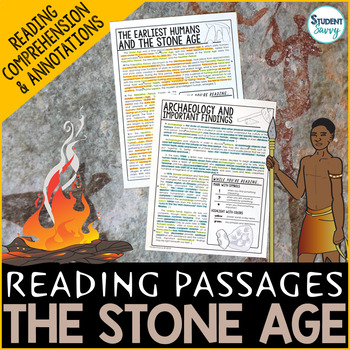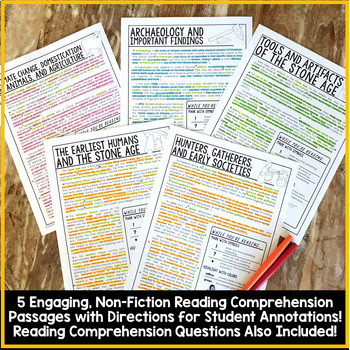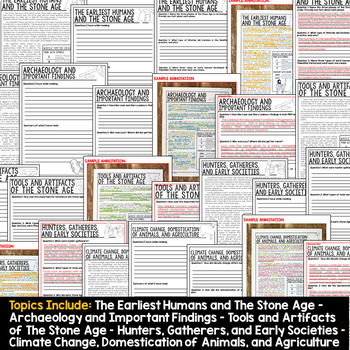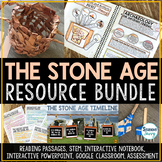Early Humans The Stone Age Reading Comprehension Passages Questions Activities
- PDF
- Easel Activity
What educators are saying
Also included in
- Looking for an engaging and rigorous Ancient Civilization Activities and Social Studies Curriculum that covers The Stone Age / Archaeology, Early Humans, Archaeology, Ancient Mesopotamia, Ancient Egypt, Israel, Ancient India, Ancient China, Ancient Greece, and Ancient Rome, and is both suitable forPrice $175.00Original Price $325.86Save $150.86
- Ancient Civilizations & World History Reading Comprehension Passages, Worksheets, Questions, and Annotations Bundle! This bundle contains 8 StudentSavvy Reading Passage & Expository Text Resources! It contains a total of 40 Engaging, Non-Fiction Reading Comprehension Passages with DirectionPrice $33.00Original Price $42.00Save $9.00
- Early Human Activities | The Stone Age Resource Bundle | ArchaeologyThis bundled product contains the following 9 StudentSavvy resources!Curriculum Map & Lesson Planning Templates (Digital & Print Google Docs Microsoft Word) Morning Work | Bell Ringers (Digital Google Slides & Print) ReaPrice $27.00Original Price $41.24Save $14.24
- ALL of the Reading Comprehension Passages in the StudentSavvy Store! Nonfiction **CURRENTLY 273 Passages!**-Worksheets - Reading Comprehension Passages, Questions, and Annotations--Both Print (PDF) & Digital Options (either in Google Slides or Easel by TpT) It contains Engaging, Non-Fiction ReadPrice $195.00Original Price $302.21Save $107.21
Description
Early Humans Worksheets - The Stone Reading Comprehension Passages, Questions, and Annotations
Archeology and Paleolithic Era - Neolithic Era
This resource contains 5 Engaging, Non-Fiction Reading Comprehension Passages with Directions for Student Annotations! Reading Comprehension Questions also included!
Questions & Answer Keys for Each of the 5 Reading Passages!
COMMON CORE ALIGNED!
Quick overview of topics covered in this resource include:
1.) The Earliest Humans and the Stone Age
-Overview of the Stone Age timeline: Three Phases - Paleolithic (Old Stone Age), Mesolithic (Middle Stone Age), and Neolithic (New Stone Age)
-Paleolithic Period – Old Stone Age
-cave paintings (first recorded expressions), period of the hunters and gatherers,
-Homo habilis, Homo erectus, and Homo sapiens
-Mesolithic Period – Middle Stone Age
Early beginnings of domesticating animals and farming.
-Neolithic Period – New Stone Age
-semi-nomadic lifestyle, some villages with raised animals and crops
Keywords: Stone Age, Paleolithic Period, Mesolithic Period, Neolithic Period, Homo Habilis (handy man), Homo Erectus (upright man), Homo Sapiens (intelligent man)
2.) Archaeology and Important Findings
-Overview of Archaeology and the role of an archaeologist.
-Discoveries of artifacts (human-made objects) and fossils (human teeth, skull, and bones) and the discovery of how prehistoric people live.
-Louis and Mary Leakey
-1974 – Discovery of Lucy in Africa
-1978 – Laetoili site in Tanzania, hominid footprints preserved in volcanic ash
-1984 – Richard Leakey finds a nearly complete skeleton of a Homo erectus boy
3.) The Tools and Artifacts of the Stone Age
-Brief overview of how the early humans learned to make and control fire, as well as other important tools and discoveries. New technology and tools allowed for more control over their environment.
-The use of fire
-The use of wooden spears
-Prehistoric clothing created with fur, leaves, leather, or grass approx 200,000 BC
-sewing needles approx.. 30,000BC (made of tiny bones and ivory)
-Early humans also created hunting bows, drills, axes, awls (pierces holes in wood and leather)
- Utilized and experimented with bone, ivory, antler, and stone.
4.) Hunters, Gatherers, and Early Societies
-Overview of lifestyle – hunter and gatherers were nomads. In their nomadic lifestyle, they migrated and followed animals to hunt.
They lived in small bands (20-50 people, including children), made up of several families.
-Men hunted, women gathered berries, fruits, seeds, and nuts from wild plants. Children also worked.
-With the development of spears and specialized fishing tools, the hunters were able to catch larger amounts of prey to feed their small bands or families.
-Approx. 70,000-100,000 years ago, early humans migrated from Africa to parts of Asia and Europe. (They most likely migrated due to a depletion of resources and food)
Keywords: hunters, gatherers, small bands, migration
5.) Climate Change, Domestication of Animals, and Agriculture
-Overview of how global warming/climate change melted the ice glaciers, allowing early humans to move to new areas.
-Overview of domestication of animals
Approx. 8000-9000 BC – learned to domesticate animals and grow plants, modifying their environment to address their needs
Sheep and goats 9000BC – raised them for clothes and food
-milk and meat products as well as clothing and shelter with skin. Used bones for weapons, needles, and other tools
-Overview of Agriculture
8,000 BC early humans began planting seeds to raise crops
-Agricultural Revolution
-Slash-and-burn agriculture
-Irrigation – African farmers along the Nile were the first to use irrigation, built canals
Keywords: domestication, global warming, climate change, settlements, slash-and-burn agriculture, agricultural revolution, agriculture
You may also enjoy:
Ancient Civilizations (Entire) Curriculum
Stone Age | Early Human Timeline and Map Posters
Ancient Civilizations Interactive Notebook BUNDLE
Ancient Rome Interactive Notebook
Ancient Greece Interactive Notebook
Ancient China - Interactive Notebook
Ancient China - STEM Challenges
Ancient Israel - STEM Challenge
Ancient India - Interactive Notebook
Ancient Mesopotamia - Interactive Notebook
Ancient Egypt - Interactive Notebook
Ancient Israel Unit - Interactive Notebook
__________________________________________________________________
Tips for Savvy TpT Shoppers:
How to receive credit on TpT to use for future purchases:
• Go to your My Purchases page. Under each purchase you'll see a Provide Feedback button. Simply click it and you will be taken to a page where you can give a quick rating and leave a short comment for the product. I value your feedback greatly as it helps me determine which products are most valuable for your classroom so I can create more for you.
Be the first to know about my new discounts, FREEBIES, and products:
• Look for a green star near the top of any page within my store and click it to become a follower. You will now be able to see FREEBIES and customized emails from my store!
©2018StudentSavvy
All rights reserved by author. Permission to copy for single classroom use only. Electronic distribution limited to single classroom use only. (unless you purchase the multiple license)
____________________________________________________________










